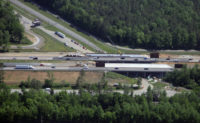The Biden administration’s American Jobs infrastructure plan includes $20 billion for a new program to address the racism inherent in highway projects in the past. Transportation veterans say this is necessary, despite criticism from conservative groups.
“There is racism physically built into some of our highways,” U.S. Dept. of Transportation (USDOT) Secretary Pete Buttigieg told theGrio’s April Ryan in an interview last week. Addressing social justice in infrastructure is one of the administration’s key goals, along with addressing climate change, safety and job creation. While some conservative critics scoff at the idea, veterans of transportation policy say the issue isn’t new.
“The idea of civil rights in transportation in the current era is not well known,” said Leslie Proll, former director of the Departmental Office of Civil Rights for USDOT under President Obama. That’s partly because it’s harder to understand than issues such as voting rights, fair housing and employment discrimination, she added.
Inadvertently illustrating that point, conservative youth group Young America’s Foundation tweeted “This is not parody” referring to Buttigieg’s comment. Embattled Congressman Matt Gaetz (R-Fla.) was more direct, tweeting “Highways are not racist.”
But transportation has long played a role in civil rights history, says Proll, providing as examples the Montgomery Bus Boycott, which brought Rosa Parks and Martin Luther King Jr. to prominence, and the Freedom Riders. The purpose of the latter, says Proll, was to test whether segregated states were following through on Supreme Court-required equal access in facilities along interstate transportation routes.
“There's a lot of hidden areas” in the discussion about equity in transportation, said Stephanie J. Jones, who was chief opportunities officer for the USDOT under Secretary Anthony Foxx in the Obama administration. Beyond a surface appearance of equity, it’s ensuring “that structures aren't built in that create obstacles for people, and that if there are obstacles, that those can be removed.” It’s a difficult task “because often people's feel as if equity means something's being taken away from them,” said Jones, who with Proll participated in an April 9 webinar, part of JTR Strategies’ Infrastructure Series.
“It’s a very touchy area, and there are a lot of feelings attached to it when we talk about civil rights enforcement,” said Jones. Even within the USDOT, it took effort to diffuse uneasiness around their work. “What we tried to do was help people see that we're not beating up on you, we're not telling you you're doing it wrong, we're not telling you you're a bad person. A lot of the problems we're trying to address are ingrained into the system, and you didn't create it and you're not purposely perpetrating it, but if you don't actively disrupt it, it's going to continue and here are ways that we can do this.”
Responding to skeptics who ask what a highway has to do with racism, Proll described the creation of the interstate highway system in the 1950s. It was set against the backdrop of civil rights litigation, specifically the US Supreme Court’s 1954 Brown v. Board of Ed decision, which declared school segregation unconstitutional. Highway routes, which federal officials set up with local and state input, were sometimes used to split Black and white communities, providing a physical barrier to integrated schools when legal barriers could no longer be used.
“These communities are still divided. They're still closed off,” said Proll.
This also explains, added Proll, why issues like housing and education are connected to infrastructure. The creation of the interstate highway system “disproportionately burdened many Black neighborhoods, and those neighborhoods are disconnected from access to high quality housing, jobs, public transit and other resources.”
The issue isn't in the distant past. In March, the Federal Highway Commission asked Texas to put a pause on plans for a Houston highway expansion while it assesses Title VI complaints that the project negatively impacts a largely Black and Latino community. Current plans would condemn 1,000 homes and 350 businesses.
“It's really important at this stage to kind of halt it and do the investigation, because with transportation, unlike a lot of other areas of civil rights … once that concrete is laid, it’s very hard to go back,” said Proll.
While Jones echoed Proll in saying the complaint came early, “this could have been done sooner if there had been in engagement with the community. It shouldn't have gotten to the point where the decision was this close to being made and then there had to be again this disruption of what was happening.”
“Communities have great input and are helpful to the planners,” she added.
Regarding the $20 billion set aside for a new program to “reconnect neighborhoods cut off” as a result of previous projects, Proll said community input will be especially effective here. “Are we going to be tearing down highways? What are we going to be putting up instead, are we going to be expanding them? You have got to have the input of the community affected. That is kind of a first principal. This can't be done by people in Washington or just at the state and local level by the officials.”
The benefits of such an approach extend both ways, said Jones. Whether “planners, private industry, whoever’s involved, it actually is to their advantage to have this kind of involvement. They get a better product, they get a much better result.”
In addition, soliciting community feedback from the start may help dissipate resistance to a project, even if a proposed road or overpass can’t be relocated. Voicing concerns can also improve projects in other ways for example, by adding easy crossing points to an overpass, adding green space, improving safety.
“Even if the result is not exactly what the community wanted,” said Jones, “if they’ve been involved with the process from the beginning, they will buy into it because they know they participated in it. They also better understand why those decisions were made.”





Post a comment to this article
Report Abusive Comment